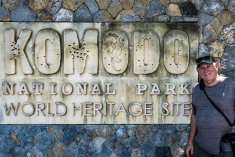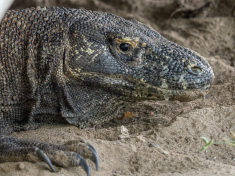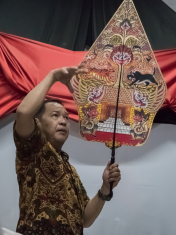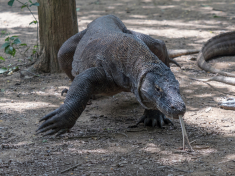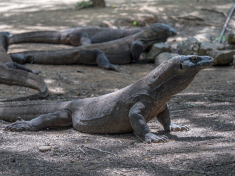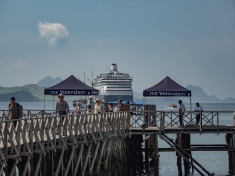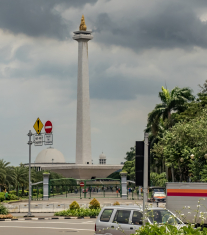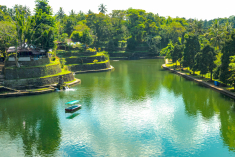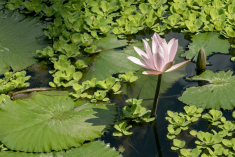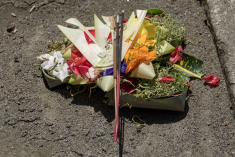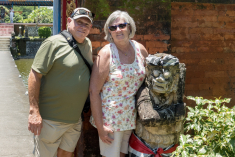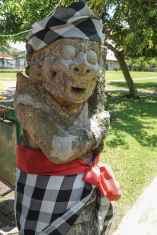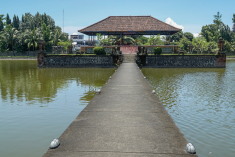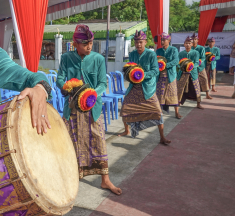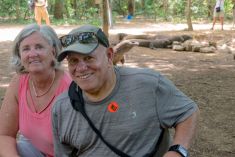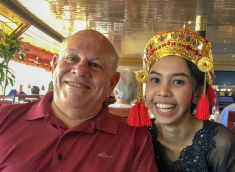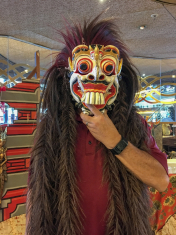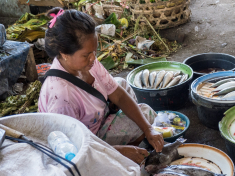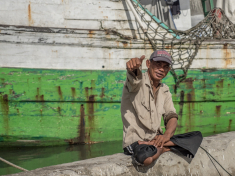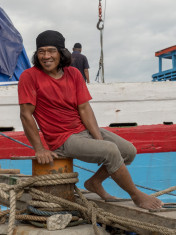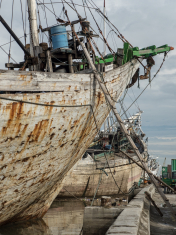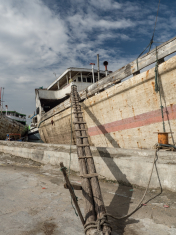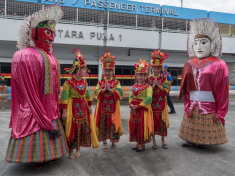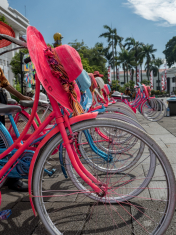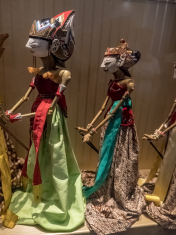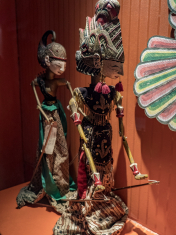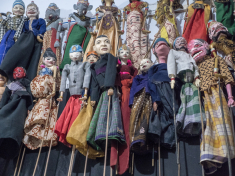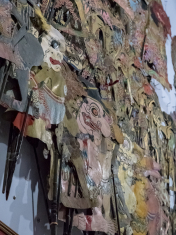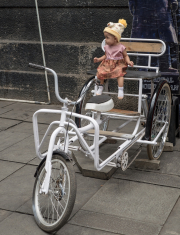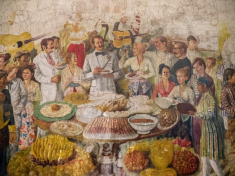It is difficult to get our heads around the denominations of their currency. For instance an average lunch for 2 costs 100,000 Indonesian Rupiah. Our first thought is, Whaaaaat??? Then laugh when we realize it is only $8 US Dollars.
The Holland America cruise Part II took us through 8 different locations in Indonesia. Two are famous: Borobudur and Bali, which are so photogenic they deserve their own blog. This blog is the “rest of the Indonesian story.” More than 1/3 of the staff from the ship were born in Indonesia. So “coming home” is a big deal. The ship has local music and dancers greet us at every port, they have Indonesian lunches where the wait staff can explain every ingredient on the plate in front of you, they quietly share it doesn’t taste as good as their mom’s cooking. The staff has dance and music performance on the main stage and you cheer especially hard for the faces you recognize. And of course, they have traditional costumes you can try on, David is a natural in this regard.
Colorful, beautiful, confusing, crowded, awe-inspiring, terrifying …overwhelming. All these words came to mind those first few moments of my local market visit in Lombok, Indonesia. It was a hot, sticky afternoon and the humid air was thick with the weirdly tantalizing olfactory mix of exotic street food, horse dung and car exhaust. That days guide in Lombok took us to see all the expected Hindu temples, and then said we needed to see the “real people” of Indonesia. The local market was a crowded warren of brightly colored stalls where they sell fruit, vegetables, meat and fish, spices, dry goods and household items. The stalls continued in all directions, with open air between (better access for the flies). We dodged puddles of stale water alongside bushels of produce, rich assortments of meat and overly pungent fruits. It was really a hidden gem, I tried to find one word to describe the market. Each smell, sound, taste, and sight brought me to one word: mesmerizing. You have to enter these markets with reckless abandon. You have to close your eyes, open your heart, and welcome every experience — no mater how overwhelming — this is how most of the world shops for their daily meal. Now my air conditioned supermarket feels very sterile.
Also near Jakarta, we strolled among rows of traditional Bugis Phinisi Schooner ships tied at dock; which are still used to move products from a city to the 9,000 inhabited Indonesian islands. The captains and mates were friendly, while I was working out that the two large poles coming from the ship was really an access ladder, we were invited aboard for a cup of tea. Fascinating as that sounds, we had only a 15 minute window of free time to explore though if I was an independent traveler, who knows the mess I would gotten into. These old, ironwood ships, left from the Dutch and British East India Companies era, have seen a lifetime of stories and storms, their character is etched on the paint laden, scratched, rusty and worn keels.
When most people think of Jakarta they think of traffic, noise, pollution, congestion. And for the most part they’re right. Jakarta is noisy, and polluted and crowded. And the traffic is horrendous. Sounds pretty interesting to me, it’s worth checking out. Jakarta is a dynamic city, The locals here are friendly, welcoming and positive. Because Jakarta is usually not on the radar of tourists, there’s an authenticity to much of it that is hard to avoid. Dutch colonial influences stand alongside those of the dominant Islam religion. We went to the old town of Batavia (now called Kota) once the hub of Dutch Colonial Indonesia. The 1.8 acre central square is teeming with tourists, both Indonesian and foreign. The activity in the central square are rows of fortune tellers, and souvenir sellers. A few Rupiah will buy a five minutes on fluorescent colored bicycles complete with helmets for gents and bonnets for ladies, or a pedal bike with a grinning fellow pumping away. We are approached by groups of giggly, polite high school students who want to have a selfie with a couple of aging Americans, which we happily oblige.
Si Jaguar Cannon has been remade from 16 smaller cannons, placed by the Dutch and gathered from around Indonesia. It has a unique and artistic end piece. The thumb appears from the fist, penetrated between the index finger and the middle finger. This kind of fist (a fig) is a vulgar sign. Placed in the heart of the Jakarta city square, F*CK you, say the Indonesians to the Dutch after 300 years of colonial rule.
Also located in Kota Square, the Wayang Museum boasts, 5,147 puppets, collected from all over Indonesia and many other parts of the world. There are two types of puppets used in Indonesia, one-dimensional paper or water buffalo leather, and three dimensional puppets of wood. The UNESCO recognized shadow puppet theaters as part of the Indonesian cultural heritage. We were lead to a workshop which doubles as a school for puppeteer apprentices for an authentic puppet show. The puppet master explained there are over one thousand characters in a puppet show, with each show lasting about nine hours. Thankfully, we got the 15 minute version, not the nine hour show. We toured the Jakarta History Museum and found a mural: In the center wall, a Dutchman holds court at a grand party, looking dapper in a white suit and tie. Javanese servants, clad in traditional lurik cloth and caps, are occupied with trays of food. Soldiers in gallant uniforms gather together while Dutch ladies in genteel kebaya sip tea and pick at hor d’oeuvres. The complete mural covers 3 walls and was painted 40 years ago and only discovered in a back room in 2010. The artist was trying to recreate life under the Dutch colonizers.
It is the national monument of the Republic of Indonesia, built to commemorate the struggle for Indonesian independence. It is based on the rice pestle and rice mortar. It is topped by a flame in gold foil.
The Indonesian archipelago is gorgeous. A few days later, as we cruised toward Komodo Island you don’t know whether to look left or right, there is so much natural beauty, and much of it is surreal. There are mountainous islands that are arid and brown, but their neighbor could have outcrops of trees and be technicolor green, a visual feast — and that’s before we meet the island’s resident Komodo dragons.
“The Komodo sat motionless under the broiling Indonesian sun. 8 feet and 170 pounds of malevolence wrapped in loose, leathery skin, from the tip of a tail so mighty it could knock a buffalo off its feet, to a mouth that dripped with fetid, bacteria filled saliva”, wrote one travel writer who fed my imagination before l could see it for myself. I was enthralled.
The Komodo dragon is a creature of legend, looking as it does, a lot like the planet’s last dinosaur left stranded in a small pocket of islands in the Indian Ocean. They are said to have lived here for at least a million years. Stories abound of the dragons attacks on those who have visited their isolated home over the years.
The Komodo dragon, the world’s largest monitor lizard, may grow to over 10 feet in length, though most males average 8.5 feet and between 170 and 200 pounds. Females are smaller than males, growing an average of 7.5 feet and weighting in at 150 to 160 pounds. Reports vary, but estimates generally put 2,500 to 5,000 Komodo dragons remain in the wild (among 4 islands), of which only about 350 may be breeding females. They are found almost everywhere on the islands. They can be found in the forest, in the savanna, on the beach, in the mangrove swamp, in the burrows or even in the trees. The younger Komodo or baby Komodo that survive hatch (their mothers know where they laid the egg, and wait at hatch to eat their young) once they crack through their shells, they will quickly climb into the trees, where they live for the next 2 to 4 years to avoid being eaten by larger dragons or other predators such as wild boar and feral pigs.
With their fearsome reputation in mind, you naturally stay back. At first sight, they do appear “lifeless” — like large seals wearing crocodile skin. When they move, they crawl on their bellies and then suddenly rear up sphinx-like, sticking out their forked tongues and making a distinctive hissing sound. There are five dragons in the group near the watering hole, the day we were there. They are grouped around each other, occasionally standing up, walking a few steps and hissing. The guides stand near with a V shaped stick, which they will use to keep the dragons back in the event that they come near us. The park itself is lovely, dappled and full of interesting trees and plants. The path is flat and smooth — a lovely walk in the woods.
A Komodo dragon’s favored method of attack is to lie in the bushes and long grass and then pounce on their prey, usually deer, feral pigs or water buffalo. Generally, they attack their prey but don’t kill it there and then. They have a poisonous saliva full of about 80 species of bacteria. So in a couple of days septicemia sets in and the prey dies. Then they can eat casually, and at their convenience. Also, they are strong swimmers, so they could follow a fleeing human into the sea. This last point was explained in detail by the security officers when asked if we could take a little swim.
The island of Lombok is just 27 miles east of Bali. It is home to two cultures, the Balinese Hindu and the Sasak Muslim. The Sasaks, who came from northern India centuries ago, their religious practices are more animist and Hindu than Muslim.
We visited Pura Meru, the largest Balinese temple on Lombok. Constructed in 1720, Pura Meru is arranged around three courtyards full of small Meru shrines. The three most important — those to Shiva, Vishnu and Brahma are in the central courtyard. We went to Suranadi, a hill town whose Hindu temple is especially venerated for its spring water and eels. Both promise good fortune. Narmada Taman, Lombok most famous temple palace complex. I note the names mostly so I can look them up again.
What was truly fascinating is how all this fits together in one spiritual place. All over Lombok you see black and white checkered cloth draped over trees, statues and worn by people in ceremonies. This special cloth has spiritual meaning. The outermost layer of spiritualism is an area where the difference between “black and white” is still visible and obvious. Those that can easily differentiate between good and evil, right and wrong, happiness and sorrow are considered to have a spiritual level that is still within the outer layer. People can be swayed between 2 opposites. That is why this cloth is only used in the outer area of temples or worn by people during ceremonies that takes place in the outer area.
The deeper someone’s spiritual understanding gets the less obvious the lines between “black and white”. They can see that sorrow is part of happiness, find enlightenment in past mistakes, understand that nothing is truly bad, and can accept both sorrow and joy as God’s gift.
Sometimes you can see it draped over a tree on the side of the road. In this case it is used to mark the tree to show that a spirit resides within it. The locals then pay their respect in some way when they pass this tree, for example, say a quick prayer. All things have a deep seated and singular spiritual component. So you bless these things every day, never taking them for granted. Little hand woven baskets filled with fruit, petals and rice grain offerings, and incense. Local women make the basket offerings fresh every morning. Then they put on a beautiful sarong & waist sash, grab incense sticks and their baskets and proceed to place them at key points around their home, garden, private temples and properties. This is an important, integral part of daily life. These little baskets of flowers and incense sticks are what make Bali/ Lombok so wonderfully unique and fragrant.
If you enter a temple, they expect you are there for a spiritual purpose, not tourism. So you are required to have religious dress: The Hindu Council says those who pray to God must put on at least a white or yellow sash over a clean garment, and cover obscene parts of the body, which for men and women is the arm pit and the back of the knee. Thus the phrase, No sarong, no sash, no service.
Within the temple there is the lucky fountain where you throw a coin, and the underground springs that bubble up into pools and baths; the pure water is used for rituals and cleansing and an extra benefit of being a fountain of youth, guaranteed to remove 10 years from your age. As it happened, our dinner table mates were visiting the same temple and saw me ritually cleaning my hands and washing my face. The man remarked that it must have worked, I don’t look a day under 70 any longer. After a horrifying look from me, and a wink from David, he dutifully changed that malicious remark to a day under 40. We continued to let him eat after our table, after much apology.




